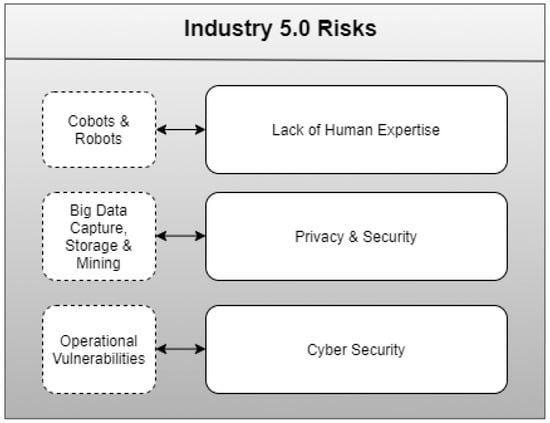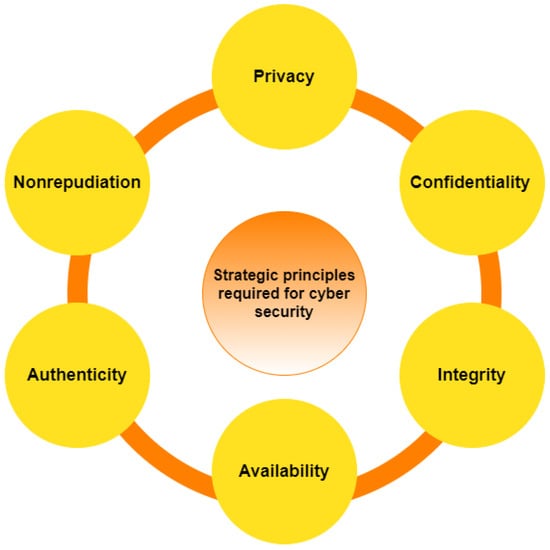Industry 4.0, which was proposed ten years ago to address both the industry’s strengths and faults, has finally been replaced by Industry 5.0. It seeks to put human welfare at the core of manufacturing systems, achieving societal goals beyond employment and growth to firmly provide wealth for the long-term advancement of all of humanity. The purpose of this research is to examine the risks involved in the adoption of Industry 5.0’s architecture. The paper discusses the significance of Industry 5.0 and the advanced technology needed for this industrial revolution, followed by a detailed discussion of Industry 5.0’s human-centric strategy. The comprehensive literature review has resulted in the identification of risks and their mitigation strategies in Industry 5.0 architecture. A taxonomy with respect to different categories of risks has also been proposed. This study classifies Industry 5.0 system assets, identifies platform-independent risks, and develops countermeasures to protect against potential threats, irrespective of the business or domain.
- ndustry 4.0
- Industry 5.0
- cyber security
- IIoT
- cobot
- AI
- DoS
1. Introduction
2. Industry 4.0 Overview
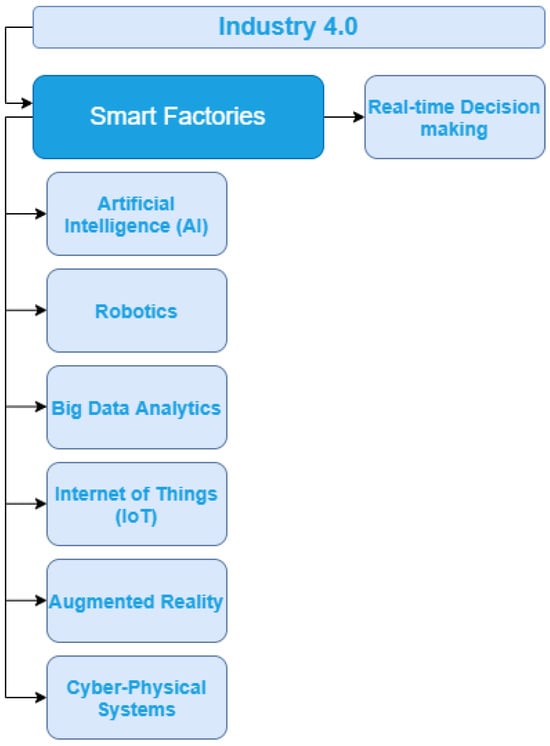
3. Industry 5.0 Overview
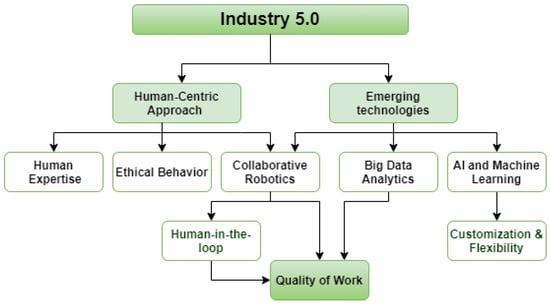
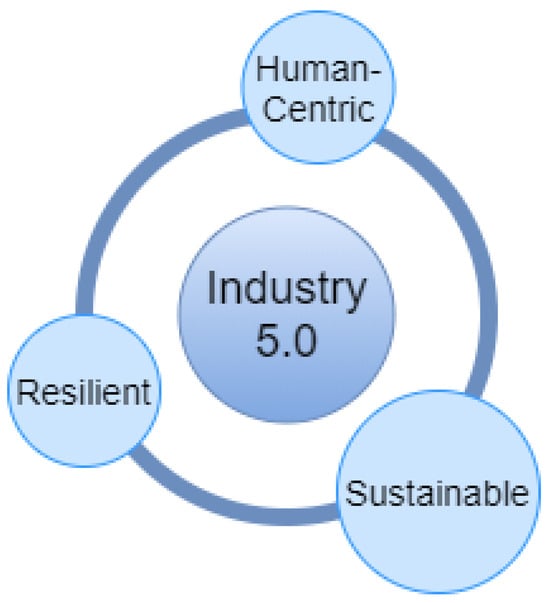
4. Concept of Industry 5.0
5. Difference between Industry 4.0 and Industry 5.0
6. Threats and Risks Involved
7. Cybersecurity Risks
Over the past few years, interest in cyber security has significantly increased. As our world becomes increasingly connected, real-time system availability is becoming increasingly important. As a result, enterprises must pay close attention to maintaining and preserving their information assets to prevent the effects that cyberattacks may have on them. The assets play a big role in critical corporate operations. Additionally, users and customers are increasingly appreciating the value of the information provided by various technologies. A cybersecurity risk is the result of the likelihood that a cybersecurity-related incident will occur and its possible effects. It includes a variety of hazards with different technology, attack routes, and techniques, but they all have two things in common: they might have a big impact, and people might think that they are improbable. To identify and manage these dangers, which were previously viewed as unlikely and hence received little attention, cyber security entails activities. Due to their unpredictable nature and the requirement for specialized ways to detect and classify them, cybersecurity risks require a different strategy for management than other categories of hazards [58][32]. Confidentiality, integrity, and availability are the three main security objectives as shown in Figure 8, and in a cybersecurity attack, these objectives are violated, leading to attacks on digital systems, networks, and data. It considers the potential for unauthorized access, data breaches, system outages, and data theft.8. Operational and Implementation Risks
The difficulties and unknowns that organizations encounter when implementing new technology or procedures are referred to as operational and implementation risks. The practical ramifications of introducing new systems, practices, or strategies within an organization are tied to these risks. They can result from several things, including human errors, technical difficulties, poor planning, and opposition to change. Operational risk is the potential for a loss brought on by either outside events or insufficient or poor internal processes, people, or systems [59][34]. Contrarily, implementation risks concentrate on the difficulties and barriers that appear when implementing new technology or procedures. These hazards could include issues with adjusting to new systems, a lack of personnel training and knowledge, and insufficient funding or resources for implementation.9. Workforce and Training Risks
Risks related to the workforce’s capacity and readiness for utilizing new technology or processes are referred to as workforce and training risks. Particularly in the context of technical breakthroughs and digital revolutions like Industry 4.0, these risks are concentrated around the human resource component of adopting new projects. On the other hand, training hazards might include insufficient training programs, resistance to training, the cost of training, etc., in the workforce, which could include a shortage of competent workers, a competency gap, a generational difference, etc. Risks related to the workforce and training must be effectively addressed if new technologies are to be successfully implemented and used.References
- Apriliyanti, M. Challenges of The Industrial Revolution Era 1.0 to 5.0: University Digital Library In Indoensia. Libr. Philos. Pract. 2022, 1–17.
- Yavari, F.; Pilevari, N. Industry revolutions development from Industry 1.0 to Industry 5.0 in manufacturing. J. Ind. Strateg. Manag. 2020, 5, 44–63.
- Castelo-Branco, I.; Oliveira, T.; Simões-Coelho, P.; Portugal, J.; Filipe, I. Measuring the fourth industrial revolution through the Industry 4.0 lens: The relevance of resources, capabilities and the value chain. Comput. Ind. 2022, 138, 103639.
- Soori, M.; Arezoo, B.; Dastres, R. Internet of things for smart factories in industry 4.0, a review. Internet Things Cyber-Phys. Syst. 2023, 3, 192–204.
- Akundi, A.; Euresti, D.; Luna, S.; Ankobiah, W.; Lopes, A.; Edinbarough, I. State of Industry 5.0—Analysis and identification of current research trends. Appl. Syst. Innov. 2022, 5, 27.
- Zizic, M.C.; Mladineo, M.; Gjeldum, N.; Celent, L. From industry 4.0 towards industry 5.0: A review and analysis of paradigm shift for the people, organization and technology. Energies 2022, 15, 5221.
- Golovianko, M.; Terziyan, V.; Branytskyi, V.; Malyk, D. Industry 4.0 vs. Industry 5.0: Co-existence, Transition, or a Hybrid. Procedia Comput. Sci. 2023, 217, 102–113.
- Gladysz, B.; Tran, T.a.; Romero, D.; van Erp, T.; Abonyi, J.; Ruppert, T. Current development on the Operator 4.0 and transition towards the Operator 5.0: A systematic literature review in light of Industry 5.0. J. Manuf. Syst. 2023, 70, 160–185.
- Adel, A. Future of industry 5.0 in society: Human-centric solutions, challenges and prospective research areas. J. Cloud Comput. 2022, 11, 40.
- Wang, B.; Zhou, H.; Li, X.; Yang, G.; Zheng, P.; Song, C.; Yuan, Y.; Wuest, T.; Yang, H.; Wang, L. Human Digital Twin in the context of Industry 5.0. Robot. Comput.-Integr. Manuf. 2024, 85, 102626.
- Paschek, D.; Mocan, A.; Draghici, A. Industry 5.0—The expected impact of next industrial revolution. In Proceedings of the Thriving on Future Education, Industry, Business, and Society, Piran, Slovenia, 15–17 May 2019; MakeLearn and TIIM International Conference. pp. 15–17.
- Longo, F.; Padovano, A.; Umbrello, S. Value-oriented and ethical technology engineering in industry 5.0: A human-centric perspective for the design of the factory of the future. Appl. Sci. 2020, 10, 4182.
- Ghobakhloo, M.; Iranmanesh, M.; Mubarak, M.F.; Mubarik, M.; Rejeb, A.; Nilashi, M. Identifying industry 5.0 contributions to sustainable development: A strategy roadmap for delivering sustainability values. Sustain. Prod. Consum. 2022, 33, 716–737.
- Grabowska, S.; Saniuk, S.; Gajdzik, B. Industry 5.0: Improving humanization and sustainability of Industry 4.0. Scientometrics 2022, 127, 3117–3144.
- Moroa, S.; Cauchick-Miguela, P.; de Sousa-Zomerb, T.; de Sousa Mendesc, G. Design of a sustainable electric vehicle sharing business model in the Brazilian context. Int. J. Ind. Eng. Manag. (IJIEM) 2023, 14, 147–161.
- Jankovic-Zugic, A.; Medic, N.; Pavlovic, M.; Todorovic, T.; Rakic, S. Servitization 4.0 as a Trigger for Sustainable Business: Evidence from Automotive Digital Supply Chain. Sustainability 2023, 15, 2217.
- Sofic, A.; Rakic, S.; Pezzotta, G.; Markoski, B.; Arioli, V.; Marjanovic, U. Smart and Resilient Transformation of Manufacturing Firms. Processes 2022, 10, 2674.
- Dave, D.M. Advancing Resilience and Agility in Manufacturing through Industry 5.0: A Review of Digitization, Automation, and Advanced Analytics. Int. J. New Technol. Res. (IJNTR) 2023, 9, 5–12.
- Alves, J.; Lima, T.M.; Gaspar, P.D. Is Industry 5.0 a Human-Centred Approach? A Systematic Review. Processes 2023, 11, 193.
- Maddikunta, P.K.R.; Pham, Q.V.; Prabadevi, B.; Deepa, N.; Dev, K.; Gadekallu, T.R.; Ruby, R.; Liyanage, M. Industry 5.0: A survey on enabling technologies and potential applications. J. Ind. Inf. Integr. 2022, 26, 100257.
- Turner, C.J.; Garn, W. Next generation DES simulation: A research agenda for human centric manufacturing systems. J. Ind. Inf. Integr. 2022, 28, 100354.
- Eriksson, K.; Alsaleh, A.; Behzad Far, S.; Stjern, D. Applying Digital Twin Technology in Higher Education: An Automation Line Case Study. Adv. Transdiscipl. Eng 2022, 21, 461–472.
- Pozo, E.; Patel, N.; Schrödel, F. Collaborative Robotic Environment for Educational Training in Industry 5.0 Using an Open Lab Approach. IFAC-PapersOnLine 2022, 55, 314–319.
- Fatima, Z.; Tanveer, M.H.; Waseemullah; Zardari, S.; Naz, L.F.; Khadim, H.; Ahmed, N.; Tahir, M. Production plant and warehouse automation with IoT and industry 5.0. Appl. Sci. 2022, 12, 2053.
- Clim, A. Cyber security beyond the Industry 4.0 era. A short review on a few technological promises. Inform. Econ. 2019, 23, 34–44.
- Toma, A.; Constantinescu, R.; Zota, R. Enhancing administrative services through document models. In Proceedings of the 5th International Conference Knowledge Management: Projects, Systems and Technologies, Bucuresti, Romania, 12–13 November 2010; pp. 94–102.
- Tinica, G.; Bostan, I.; Grosu, V. The dynamics of public expenses in healthcare and demographic evolution in Italy and Romania. Rev. Romana Bioet. 2008, 6, 48–63.
- Kamel, S.O.M.; Hegazi, N.H. A proposed model of IoT security management system based on a study of internet of things (IoT) security. Int. J. Sci. Eng. Res. 2018, 9, 1227–1244.
- Sanmartin, P.; Rojas, A.; Fernandez, L.; Avila, K.; Jabba, D.; Valle, S. Sigma routing metric for RPL protocol. Sensors 2018, 18, 1277.
- Waslo, R.; Lewis, T.; Hajj, R.; Carton, R. Industry 4.0 and cybersecurity: Managing risk in an age of connected production. Erişim tarihi 2017, 15.
- Pedreira, V.; Barros, D.; Pinto, P. A review of attacks, vulnerabilities, and defenses in industry 4.0 with new challenges on data sovereignty ahead. Sensors 2021, 21, 5189.
- Rea-Guaman, A.; San Feliu, T.; Calvo-Manzano, J.; Sánchez-García, I.D. Systematic review: Cybersecurity risk taxonomy. In Trends and Applications in Software Engineering, Proceedings of the 6th International Conference on Software Process Improvement (CIMPS 2017), Zacatecas, Mexico, 18–20 October 2017; Springer: Cham, Switzerland, 2018; pp. 137–146.
- Khan, M.; Haleem, A.; Javaid, M. Changes and improvements in Industry 5.0: A strategic approach to overcome the challenges of Industry 4.0. Green Technol. Sustain. 2023, 1, 100020.
- Jarrow, R.A. Operational risk. J. Bank. Financ. 2008, 32, 870–879.

